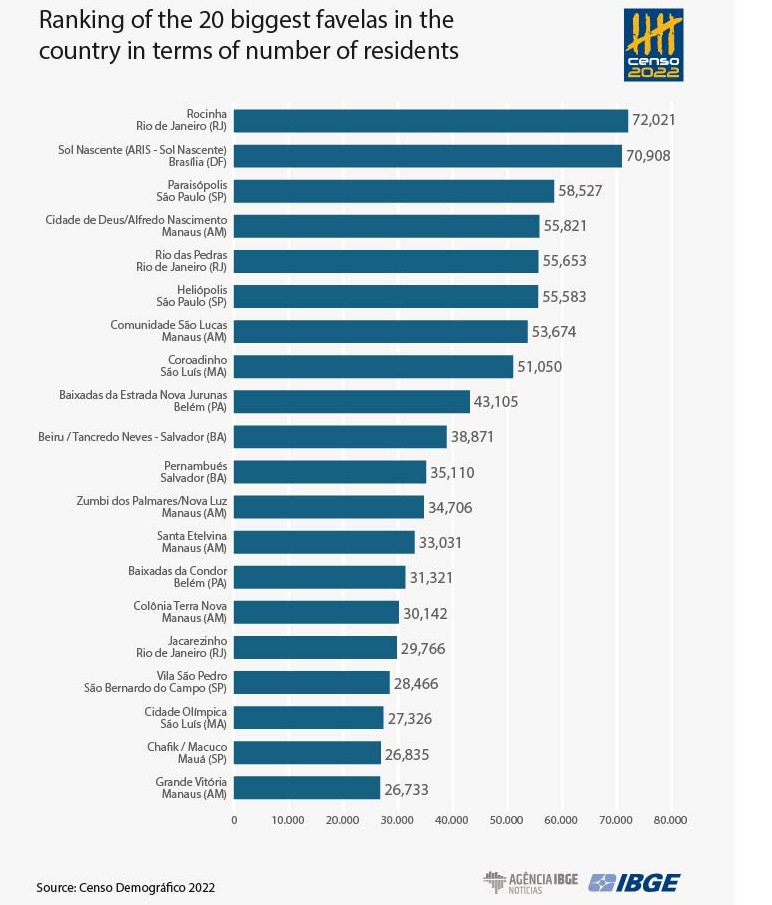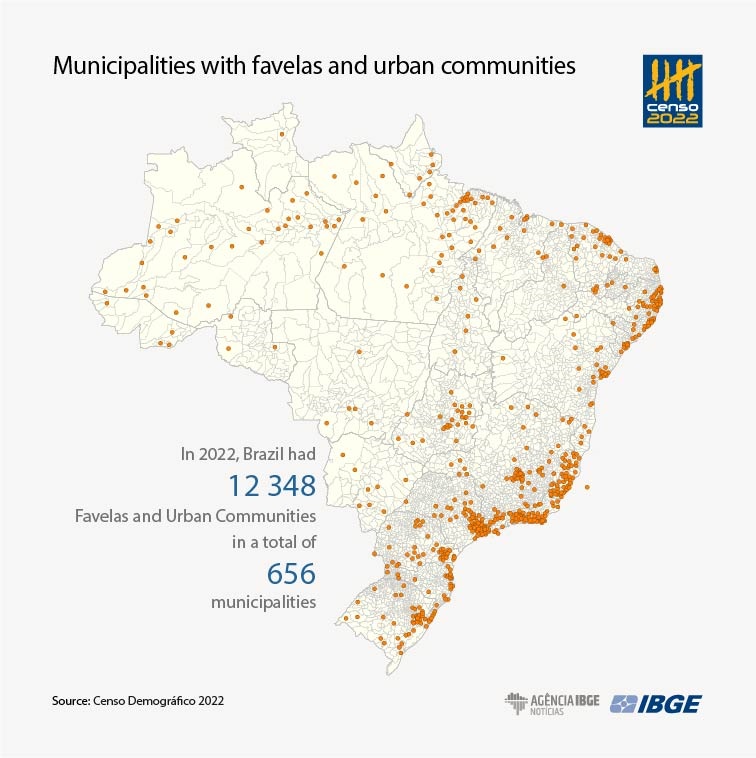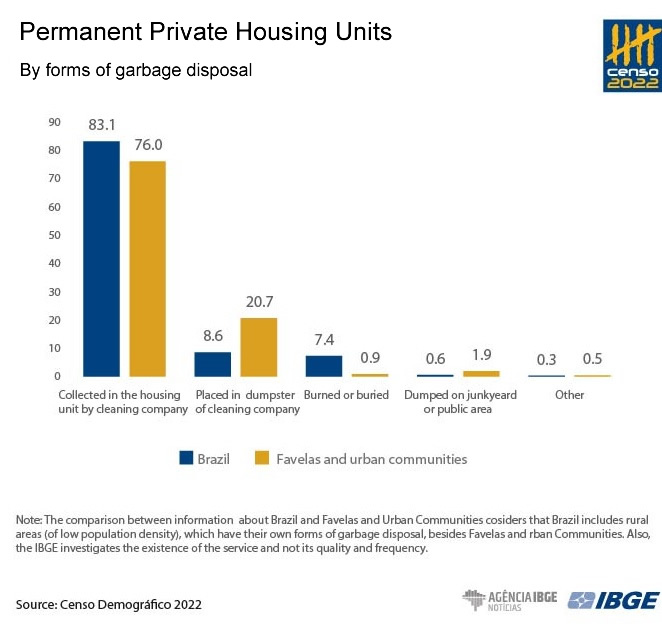2022 Census
2022 Census: 16.4 million persons in Brazil lived in Favelas and Urban Communities
November 08, 2024 10h00 AM | Last Updated: January 07, 2025 10h34 AM
Highlights
- The 2022 Census found 12,348 Favelas and urban Communities, the home of 16,390,815 persons, which represents 8.1% of the country's population. In 2010, 6,329 Favelas and Urban Communities were identified, being inhabited by 11,425,644 persons, or 6.0% of the population in Brazil that year.
- Among the 12,348 Favelas and urban Communities in the country, Rocinha, in Rio de Janeiro (RJ), for example, was the most populous ones (72,021 residents), followed by Sol Nascente, in Brasília (DF), with 70,908 residents; Paraisópolis, in São Paulo (SP), with 58,527 persons and Cidade de Deus/Alfredo Nascimento, in Manaus (AM), with 55,821 residents.
- Seven of the eight most populous Favelas and Urban Communities in the country were in the North Region (seven in Manaus), seven in the Southeast, four in the Northeast and only one (Sol Nascente) in the Central West.
- The Federation Units with the biggest proportion of the population living in Favelas and Urban Communities were Amazonas (34.7%), Amapá (24.4%) and Pará (18.8%).
- Rio das Pedras is the number two regarding number of housing units (23,846 housing units), preceded by Rocinha (30,371 unidades) and followed by Sol Nascente (21,889 housing units).
- The population of the favelas was younger than that of the country as a whole. The median age of the country's population was 35 and, in Favelas and Urban Communities, 30. The distribution by sex of the population in Favelas was virtually the same as in the rest of the country.
- The ageing index of Favelas and urban Communities was 45.0, that is, there were 45 elderly people (aged 60 and over) per every 100 children aged 0 to 14, significantly below that for the country's population (80.0 elderly persons per every 100 children).
- The proportions of brown (56.8%) and black (16.1%) persons in the population of Favelas and Urban Communities were higher than the percentages observed in the total population (respectively 45.3% and 10.2%). on the other hand, the proportion of white persons in the country's population (43.5%)was significantly above the percentage observed in the population of Favelas and Urban Communities (26.6%).
- Among the 958,251 establishments found by the 2022 Census in Favelas and Urban Communities, 7,896 were teaching institutions, 2,792 were heath establishments and 50,934 were religious establishments. Proportionally, in Favela and Urban Communities there were 18.2 religious establishments per every health establishment and 6.5 religious establishments per every teaching institution.

The 2022 Population Census found 12,348 Favelas and Urban Communities in Brazil, inhabited by 16,390,815 persons, which represents 8.1% of the country's population. In 2010, 6,329 Favelas and urban Communities were identified, the home of 11,425,644 persons, or 6.0% of the population that year. This increase is also due to the technological improvements adopted in the census operation and to a better knowledge of the territory, which improves the surveying of information about this population in the period between censuses. The comparison of results between the two censuses, concerning Favelas and Urban Communities must consider this context and dealt with carefully.
The data are being released today by the IBGE. The release event, at 10 am, will be at Areninha Cultural Herbert Vianna, located in Maré, a favela in Rio de Janeiro (RJ). It will be streamed live on Digital IBGE. The data will also be available on Sidra, the Interactive Geographic Platform (PGI) and the Census Overview.
The IBGE has conducted surveys on Favelas and Urban Communities since 1950 and improved the approach of this topic in population censuses. There is inherent difficulty to measure these territories as they are extremely dynamic and, to a great extent, do not have either officially established boundaries or registered housing units.
In 2010, the population of each one of the favelas and urban communities, found by the IBGE enumerators, was released for the first time. In 2022, the IBGE counted on georeferenced data from ANEEL to help in data collection and made use of better digital resources than in the previous decade, including satellite images.
Cayo Franco, coordinator of Geography at the IBGE, adds: “In the years that preceded the 2022 Census the dialogue with organizations and entities that represent favelas and communities was gradually expanded, as these not only took part in the census operation, but also worked in the redefinition of the terminology used by the IBGE, which replaces the designation “Subnormal Agglomerates” for “Favelas and urban Communities”.
At the end of the counting phase of the 2022 Census, the IBGE conducted the campaign “Favela on the Map” in partnership with the Data Favela Institute and Central Única das Favelas (Cufa), with the objective of guaranteeing full coverage of the Population Census in favelas and urban communities. The national campaign was important so that those municipalities and residents not yet enumerated could have the opportunity to be in this portrait of national reality.
Rocinha is the most populous favela in the country
Among the 12,348 Favelas and urban Communities in the country, Rocinha, in Rio de Janeiro (RJ), was the most populous one, with 72,021 residents, followed by Sol Nascente, in Brasília (DF), with 70,908 residents; Paraisópolis, in São Paulo (SP), with 58,527 residents and Cidade de Deus/Alfredo Nascimento, in Manaus (AM), with 55,821 residents.
Among the 20 most populous Favelas and Urban Communities in the country, eight were in the North Region, and six of them, in the municipality of Manaus (AM). Other seven were in the Southeast, four in the Northeast and only one (Sol Nascente) in the Central West. The South Region did not have any favela among the 20 most populous ones in the country.
The Federation Units with the biggest proportions of the population living in Favelas and Urban Communities were Amazonas (34.7%), Amapá (24.4%) and Pará (18.8%).

Rio das Pedras is the second biggest favela considering number of housing units
The list of 20 favelas with the biggest number of permanent private housing units is slightly different of the list of 20 most populous ones: Rocinha, in Rio de Janeiro (RJ), leader in number of housing units, also had the most occupied permanent private housing units (30,371).
Letícia Giannella, a researcher at the IBGE, observes that “Sol Nascente, in Brasília (DF), with the second biggest resident population, was the third in terms of housing units (21,889 housing units). And the second favela in this ranking by housing units was Rio das Pedras, no Rio de Janeiro (RJ), with 23,846 housing units. This favela is also the fifth most populous in the country, with 55,653 residents”.
Favelas and Urban Communities had 5.6 million occupied housing units
The 2022 Census found 6,556,998 housing units in Favelas and Urban Communities all over the country, of which 5,557,391 (or 84.8%) were occupied permanent private housing units.
About 93.3% of the housing units in the favelas are houses, a higher proportion than in the total housing units in the country (82.3%). Only 2.8% of the housing units in Favelas are apartments, whereas in the total housing units in the country, 14.95 are apartments.
Letícia Giannella comments on the verticalization of the favelas: “in the state of Rio de Janeiro, 7.0% of the housing units (or 55,570) in Favelas and Communities are apartments, the biggest proportion among Federation Units. In São Paulo, the most populous state in the country, only 0.5% of the housing units (or 6,278) in Favelas and Communities were apartments.”
Favelas are predominant in Big Urban Concentrations
About 83.5% of the Favelas and Communities were in big Urban Concentrations in the country. Two of these concentrations, both in the North Region, had more than 50% of their housing units in Favelas and Communities: Belém (PA), 55.8% and Manaus (AM), 53.9%.

Urban municipalities are communities (or groups of municipalities) with a population above 100 thousand residents, a high level of integration and that form urban areas resulting from the expansion of one or more cities. They are considered big Urban Concentrations and population arrangements above 750,000 residents.
General water supply system serves 86.4% of the housing units in favelas
In 2022, 83.9% of all the occupied permanent private hosuing units had a general system and used it as the main form of water supply. Among the occupied permanent private housing units in the Favelas and urban Communities, this percentage was 86.4%.
The states with the smallest percentages of housing units with a general system as the main form of water supply were Rondônia (23.3%), Pará (53.6%), Roraima (59.0%) and Amapá (59.6%). The biggest percentages were found in Bahia (98.1%), Piauí and Rio Grande do Norte (both with 97.8%) and Espírito Santo (97.5%).
Sewage system reaches 74.6% of the housing units in favelas and urban communities
In Brazil, in 2022, sewage disposal of 77.4% of the housing units were connected to the general system, rainwater network, sceptic tank or filter. In Favelas and Urban Communities this percentage was 74.6%. Amapá (28.1%), Mato Grosso do Sul (37.1%), Rondônia (39.5%) and Alagoas (40.1%) had the smallest percentages and Bahia (89.3%), Rio de Janeiro (86.2%), Minas Gerais (86.1%) and Espírito Santo (84.9%), the highest.

Another highlight is the percentage of housing units in favelas whose type of sewage disposal was ditch (4.0%) and river, lake, stream or sea (7.9%). For the total housing units in the country, including rural areas, this proportion was, respectively, 1.4% and 1.9%.
Approximately 99.9% of the housing units in Favelas and Urban Communities had a bathroom and toilet for exclusive use of the housing unit.
In 20.7% of the housing units in favelas, garbage is collected in dumpsters
The garbage collection services (in the housing unit or by means of dumpsters) served 91.7% of the occupied permanent private housing units in Brazil, in 2022. In Favelas and Urban Communities, this service was rendered to 96.7% of the occupied permanent private housing units.
The average percentage of the country for this kind of service is smaller than in Favelas and Urban Communities. Also, in 20.7% of the housing units in favelas and urban Communities, dumpsters were used for garbage collection, whereas in the average of the country, this percentage was 8.6%.
Santa Catarina (99.1%), Paraná (98.7%) and Espírito Santo (98.6%) had the highest highest rates of garbage collection per type of cleaning service, directly in the housing unit or by means of dumpsters, and Roraima (84.3%), Alagoas (92.1%) and Maranhão (92.5%), the lowest.

Proportion of white persons in Favelas is smaller than the national average
The proportions of persons who reported being brown (56.8%) and black (16.1%) in the population of Favelas and Urban Communities is above the percentages observed in the total population (respectively 45.3% and 10.2%). On the other hand, the proportion of white persons in the country’s population (43.5%) is significantly higher than the percentage observed in Favelas and urban Communities (26.6%). The proportion of indigenous population in Favelas and Urna Communities is the same as the total population in the country, 0.8%.
Letícia recalls that, “between the Censuses of 2010 and 2022, either in the total population or in the population of Favelas and urban Communities, there was a drop of in the proportion of persons who reported being black or brown.”
In the North Region, 12.6% of the indigenous population lived in favelas and Urban Communities. In Amazonas, this proportion reached 17.9% and, in Rio de Janeiro, 12.7%. in São Paulo, the most populous state, the proportion of indigenous persons living in Favelas and Urban Communities was 9.6%.
Population of favelas is the youngest
The population of favelas is the youngest in the entire country. The median age of the country’s population was 35, and, in Favelas and Urban Communities, 30.
The ageing index in Favelas and Communities is 45 elderly persons (aged 60 and over) for each 100 children aged 0 to 14, much lower than that of the country’s population (80 elderly persons for each 100 children). The disparity between the ageing indexes of the total population and of that in Favelas and Communities was highest, respectively, in the Southeast (98 to 46) and in the South (95 to 43) and lowest in the North (41 to 38).
The distribution of the population by sex in Favelas and Urban Communities (48.3% for men and 51.7% for women) did not differ significantly from that in the entire country (48.5% for men and 51.5% for women).
Favelas têm 6,5 estabelecimentos religiosos para cada escola
Among the 958,251 establishments found by the 2022 Census in Favelas and Communities, 7,896 were teaching establishments, 2,792 were health establishments and 50,934 were religious establishments. Proportionally, in Favelas and Urban Communities, there were 18.2 religious establishments for each health establishments and 6.5 establishments for each teaching ones. It is worth of mention that 64.3% of the total establishments in Favelas and Urban Communities, in 2022, 64,3%, were establishments for other purposes (garages, banks, pharmacies, offices, shops and trade establishments in general, etc.) and 29.1% of the buildings were being constructed or refurbished.
In relation to the total establishments in the country (released by the IBGE in June this year, see here), favelas and communities concentrate 8.8% of the religious establishments, 7.9% of the buildings being constructed or refurbished, 3.0% of the teaching establishments and 1.1 health establishments.
More about the survey
The Population Census is the most complete statistical operation conducted in the country, visiting all the 5,570 Brazilian municipalities and collecting the addresses and geographic coordinates of types of addresses visited by the enumerators. This release presents information about the number of favelas and urban communities, the resident population of these areas, besides the number of housing units, information on public sanitation and the different types of establishments.
The data will be made available for the geographies Brazil, Major Regions, Federation Units, Urban Concentration, Municipalities, favelas and Urban Communities. In the case of analyses of indigenous persons, the results were also released for the Legal Amazon.
The results can be accessed on the IBGE website and on platforms such as SIDRA, the Census overview and the Interactive Geographic Platform (PGI), and, in these last two ones, they are also available by means of interactive maps.
The geography Favelas and Communities was updated on the Geographic Reference Chart for the production, analyses and dissemination of Statistics.




















